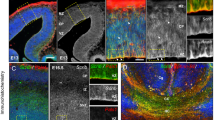Abstract
The gene tailless is a member of the superfamily of genes that encode transcription factors of the ligand-activated nuclear receptor type, and is expressed in the invertebrate and vertebrate brain1,2,3,4. In mice, its transcripts are restricted to the periventricular zone of the forebrain4, the site of origin of neurons and glia. Here we use homologous recombination to generate mice that lack a functional tailless protein. Homozygous mutant mice are viable at birth, indicating that tailless is not required for prenatal survival; however, adult mutant mice show a reduction in the size of rhinencephalic and limbic structures, including the olfactory, infrarhinal and entorhinal cortex, amygdala and dentate gyrus. Both male and female mice are more aggressive than usual and females lack normal maternal instincts. These animals therefore enable a molecular approach to be taken towards understanding the genetic architecture and morphogenesis of the forebrain.
This is a preview of subscription content, access via your institution
Access options
Subscribe to this journal
Receive 51 print issues and online access
$199.00 per year
only $3.90 per issue
Buy this article
- Purchase on Springer Link
- Instant access to full article PDF
Prices may be subject to local taxes which are calculated during checkout





Similar content being viewed by others
References
Pignoni, F. et al. The Drosophila gene tailless is expressed at the embryonic termini and is a member of the steroid receptor superfamily. Cell 62, 151–163 (1990).
Weigel, D., Jurgens, G., Kilnger, M. & Jäckle, H. Two gap genes mediate maternal terminal pattern information in Drosophila. Science 248, 495–498 (1990).
Yu, R. T., McKeown, M., Evans, R. M. & Umesono, K. Relationship between Drosophila gap gene tailless and a vertebrate nuclear receptor Tlx. Nature 370, 375–378 (1994).
Monaghan, A. P., Grau, E., Bock, D. & Schuetz, G. The mouse homolog of the orphan nuclear receptor tailless is expressed in the developing forebrain. Development 121, 839–853 (1995).
Mangelsdorf, D. J. et al. The nuclear receptor superfamily: The second decade. Cell 83, 835–839 (1995).
Reznikov, K. Y. Cell proliferation and cytogenesis in the mouse hippocampus. Adv. Anat. Embryol. Cell Biol. 122, 1–74 (1991).
Keefe, J. O. & Nadel, L. The Hippocampus as a Cognitive Map (Clarendon, London, (1978)).
Morris, R. G. M. et al. Place navigation impaired in rats with hippocampal lesions. Nature 297, 681–683 (1982).
Morris, R. G. M. Development of the watermaze procedure for studying spatial learning in the rat. J. Neurosci. Meth. 11, 47–60 (1984).
Kandel, E. R., Schwartz, J. H. & Jessell, T. Essentials of Neural Science and Behavior (Prentice Hall International, London, (1995)).
Davis, M. The role of the amygdala in fear and anxiety. Annu. Rev. Neurosci. 15, 353–357 (1994).
Gray, J. A. The Neuropsychology of Anxiety: an Enquiry into the Functions of the Septo-Hippocampal System (Clarendon, London, (1982)).
Goodlet, C. R., Engellenner, W. J., Burright, R. G. & Donovick, P. J. Influence of environmental rearing history and post surgical environmental change on the septal rage syndrome in mice. Physiol. Behav. 28, 1077–1081 (1982).
Edwards, D. A., Nahai, F. R. & Wright, P. Pathways linking the olfactory bulbs with the medial peoptic anterior hypothalamus are important for intermale aggression in mice. Physiol. Behav. 53, 611–615 (1993).
Albert, D. J. & Walsh, M. L. Neural systems and the inhibitory modulation of agonistic behaviour: a comparison of mammalian species. Neurosci. Biobehav. Rev. 8, 5–24 (1984).
Gilad, G. M. & Reis, D. J. Collateral sprouting in central mesolimbic dopamine neurons: biochemical and immunocytochemical evidence of changes in the activity and distribution of tyrosine hydroxylase in terminal fields and in cell bodies of A10 neurons. Brain Res. 160, 17–26 (1979).
Kaestner, K. H., Hiemisch, H., Luckow, B. & Schütz, G. The HNF-3 gene family of transcription factors in mice: gene structure, cDNA sequence, and mRNA distribution. Genomics 20, 377–385 (1994).
Kaestner, K. H. et al. Universal beta-galactosidase cloning vectors for promoter analysis and gene targeting. Gene 148, 67–70 (1994).
Gass, P., Herdegen, T., Bravo, R. & Kiessling, M. Induction of immediate early gene encoded proteins in the rat hippocampus after bicuculline-induced seizures: differential expression of Krox-24, FOS and Jun proteins. Neuroscience 48, 315–324 (1992).
Tamura, T. et al. Striking homology of the ‘variable’ N-terminal as well as the ‘conserved core’ domains of the mouse and human TATA-factors (TFIID). Nucleic Acids Res. 19, 3861–3865 (1991).
Acknowledgements
We thank E. Grau, E. Schmid, S. Ridder, H. Glaser and A. Klewe-Nebenius for technical assistance; J. Blendy, H. Kaestner and M. Nichols for critically reading the manuscript; R. Lang and M. Stagliar-Bozicevic for help with behavioural analyses; W. Fleischer for help with photography; and M. Bock for secretarial assistance. This work was supported by the Deutsche Forschungsgemeinschaft, the European Community, BMBF (Forschungszentrum Jülich/Schering), Fonds der Chemischen Industrie, by the Swiss National Foundation for Scientific Research and the Human Science Frontier Programme (to H.P.L.).
Author information
Authors and Affiliations
Corresponding author
Rights and permissions
About this article
Cite this article
Monaghan, A., Bock, D., Gass, P. et al. Defective limbic system in mice lacking the tailless gene. Nature 390, 515–517 (1997). https://doi.org/10.1038/37364
Received:
Accepted:
Issue Date:
DOI: https://doi.org/10.1038/37364
This article is cited by
-
Nuclear receptors in neural stem/progenitor cell homeostasis
Cellular and Molecular Life Sciences (2017)
-
TLX—Its Emerging Role for Neurogenesis in Health and Disease
Molecular Neurobiology (2017)
-
The TLX-miR-219 cascade regulates neural stem cell proliferation in neurodevelopment and schizophrenia iPSC model
Nature Communications (2016)
-
The Orphan Nuclear Receptor TLX/NR2E1 in Neural Stem Cells and Diseases
Neuroscience Bulletin (2016)
-
Combined serial analysis of gene expression and transcription factor binding site prediction identifies novel-candidate-target genes of Nr2e1 in neocortex development
BMC Genomics (2015)
Comments
By submitting a comment you agree to abide by our Terms and Community Guidelines. If you find something abusive or that does not comply with our terms or guidelines please flag it as inappropriate.



